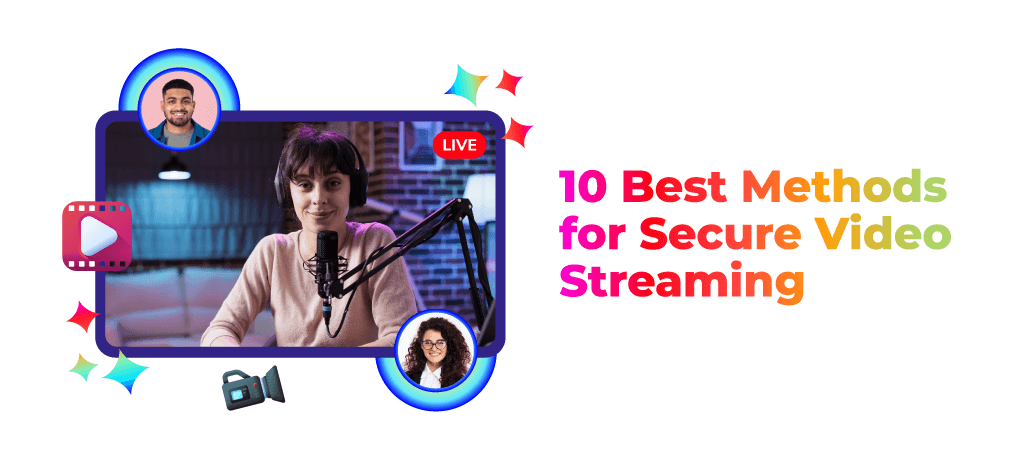Video has become a crucial part of many businesses to enhance their digital presence. Video content is used for multiple purposes, including marketing and promotions. Secure video streaming has become an important aspect for streamers, creators, and even event organizers. It is very common for online videos to be vulnerable to security breaches, hacking, and piracy. It has become a necessity to use a secure video streaming platform that can provide a seamless experience.
Digital piracy and cyber crimes have become a concerning issue, and it is estimated that they can cost $10.5 trillion by 2025. This leading concern has led to a rise in secure and safe video streaming solutions. To create an enhanced video environment for your content. In this blog, we will take a look at the best solutions for secure video streaming.
Table of Contents
What is Secure Video Streaming?
Secure video streaming is when you set security measures in place to protect video content from unauthorized access, piracy, and cyber threats. This way only the actual user is authorized to either access the video content, stream or download. As consumption of video content skyrockets, businesses, content creators, and event planners are turning increasingly to secure video steaming solutions to hold their intellectual properties and offer safe viewing.
Why Security is Crucial in Video Streaming?
As the video streaming service is receiving a wide range of audiences, the security of video streaming is very important to protect content piracy, unauthorized users, and cyber-attacks. Whether it is by way of live streaming a corporate event, broadcasting out only content that is intended for select members, or an online course, the unauthorized sharing of such things and hacking can result in lost revenue, loss of privacy, and reputational damage.
Key Threats to Video Streaming Security
Regardless of how advanced technology gets, video streaming faces several security threats. By reading about these threats, the first step has been made to mitigate the risks and ensure a safe streaming environment.
1. Content Piracy
One of pirates’ biggest enemies remains piracy. Video piracy where unauthorized users download, rebroadcast, or resell content, often without authorization, leads to dilution of the brand and financial loss. To combat piracy, we have advanced digital rights management (DRM) solutions and watermarking techniques.
2. Data Breaches
A data breach is when cybercriminals gain unauthorized access to a streaming service’s database, and in turn expose personal user information, including login information, payment information, and viewing history. Employing high-grade encryption algorithms and secure authentication practices can mitigate these types of attacks in practice.
3. DDoS Attacks
Example of a DDoS attackDistributed Denial-of-Service (DDoS) attacks are an attempt to make a machine or network resource unavailable by flooding it with traffic. Implementing cloud-based protection services as well as sophisticated firewalls helps to lessen DDoS attacks and stream without interferences.
4. MITM (Man-in-the-Middle) Attacks
In these MITM attacks, hackers intercept the data exchanged between a video streaming platform and its users to steal sensitive information or inject malicious content. These threats can be countered through secure encryption protocols like SSL/TLS, which ensure data confidentiality and integrity.
5. Token Theft
While token-based authentication is widely used in video streaming, such tokens can also be stolen by cybercriminals to gain unauthorized access. Taking short-lived tokens, IP restrictions, MFA can reduce risks of token stealing.
10 Tactics for Secure Video Streaming
Every live-streaming or normal streaming method doesn’t need to be similar. The measures used depend on the purpose of the content, the target audience, and the goal of streaming. Multiple security methods can be used to make sure that video content and sensitive information are not compromised. Let’s take a look at the top secure methods of video streaming for a seamless and elevated experience.
AES Encryption
AES (Advanced Encryption System) includes a regulated process of encoding data that only allows authorized individuals to access your video content. It is a symmetric block cipher that is chosen to protect classified information. The implementation of this software as well as hardware to protect sensitive data. It assists in keeping the video streaming content completely secure through cryptographic keys. However, it is essential for the audience to get the correct access digital key to view the content. Without a suitable key, they won’t be able to access the video content as it would jumble them over to mismatched visual content.
HTTPS Delivery
HTTPS protocol provides complete protection from data breaches and hacking. These are very common during live video streaming or any other broadcasting. This is often when open networks are utilized during accessing the video content. With the help of digital certificates & encryption keys, HTTPS delivery leverages HLS encryption. It secures the connection between source and destination to avoid malware. HTTPS protocol is one of the most excellent ways that provide seamless and secure video streaming experiences.
SSL / TLS Encrypted Paywall
SSL (Secure Socket Layer) and TLS (Transport Layer Security) are two prime security protocols. They encrypt the data exchange between the server and the user. This encryption is used in multiple industries such as banking to protect financial information. These protocols are broadly used for secure video streaming, and they protect all kinds of communications made over the internet. Video content monetization platforms use SSL and TLS to secure their video content from getting hacked or pirated.
Password Protected Videos
This format for securing the video content sounds like it is necessary to know the password to access the content securely online. It is a great way of protecting the content from unqualified viewers or from getting leaked or hacked. Password protection is an enhanced, secure video streaming method that is prone to hacking or leakage. While exploring this protocol, you need to understand the level of risks that you might be exposed to. It is a basic measure that needs to be taken to enhance the video content from the beginning.
Internet Protocol (IP) Restrictions
IP restrictions are also known as geographic restrictions. It is a method that blocks certain locations from accessing the content. While using this video streaming protocol, it is important to keep in mind that it can limit certain viewers from different regions to access the content. This is generally avoided during video live-streaming of events because it can restrict the reach, which is important for organizers in some cases. However, there are certain regions which are known for high risk for piracy or hacking then compared to others which can easily be neglected through IP restrictions.
Referrer Restrictions
If you are looking to unleash the power of secure video streaming, another method that can be implemented is referrer restrictions. This enhanced way of securing content works by whitelisting certain domains, including your websites or other URLs. When you integrate this advanced security protocol, it verifies the server through regulated systems of digital security tokens. When a video streaming has been embedded in an unauthorized site, the playback will be immediately blocked.
Secure Your CDN
As an organizer, creator, or streamer, you can deliver uploaded videos over an online platform with security across the content delivery network and data centers. A CDN is an enhanced system that delivers video & other media across the globe effectively and seamlessly. Using an online video platform integrated with CDN can help protect the data from multiple attacks. Even during the live-streaming of an event, the platform integrated with CDN will work well.
Multi-DRM Platform
This is a great way to ensure your video content and other services stay secure and protected from being used with necessary piracy and copyrights. Multi DRM video services providers include unified security to platforms with channelized route delivery along with license management features. Moreover, to integrate this complex technology seamlessly, it is recommended to choose a suitable video streaming service provider that integrates enhanced security.
Use Watermarking in Content
A common and secure video streaming method that may or may not work is to use a watermark in the video content. It depends on the kind of content that is being streamed and to whom it is being provided. However, if you are delivering video content through online video streaming platforms, there is a risk of reproduction and reposting. So it is important to let your audience know to whom the content is relevant.
Multi-factor Authentication
It is not necessary to secure your content just through passwords. It might seem tedious to put some extra effort into accessing the video streaming platform, but with an added layer of security, you can easily protect your content. This secure video streaming method protects it from any kind of leaks or hacked passwords. Moreover, it can be easily integrated into any video stream or broadcast, but make sure to provide attendees details on how they can access the content.
Challenges in Secure Video Streaming
However, video security also presents its own challenges, such as:
- Access and experience: The safeguards implemented should not hinder the access and experience of the users while streaming the content.
- Cyber Threat Evolution: Cost-free hackers are developing novel approaches to penetrate security systems, compelling the sites to incorporate forward-looking security options that can protect in the future.
- Expense of Implementation: The deployment of advanced security measures such as DRM (Digital Rights Management), encryption, and secure authentication can put a strain on budget for smaller businesses and independent creators.
- Cross-Device and Cross-Network Challenges: Streaming is done using multiple devices over varied networks, making it difficult to impose uniform security policies.
Best Practices for Implementing Secure Video Streaming
In order to address security threats and creating a safe streaming environment for businesses, here are the best practices you should adopt:
- Use Encrypted Streaming Protocols: AES encryption and delivery is on HTTPS.
- Facilitate Multi-DRM Solutions: Protect copyrighted content from unauthorized access with the help of some robust digital rights management (DRM) systems.
- Turn on Multi-Factor Authentication (MFA): An additional layer of security against unauthorized access.
- Restrict by IP/Geography: Block risk areas.
- Utilize Secure CDN (Content Delivery Networks): By utilizing CDN websites, we can protect our content from cyber threats and ensure optimal performance.
- Implement Watermarking Methods: To prevent piracy, you can embed dynamic watermarks into video streams.
Avoid Potential Threats By Repeated Updates: Be a step ahead and get your security protocols updated and also run vulnerability assessment.
Future of Secure Video Streaming
As technology continues to advance, the future of secure video streaming will depend on advanced AI-driven security measures, blockchain-based authentication, and biometric access controls. So like AI-powered anomaly detection and decentralized CDNs will ensure the safety of content against cyber threats. Next-gen security for popular and ultra-secure video streaming As the demand for ultra-secure video streaming continues to rise, companies are compelled to adopt cutting-edge security solutions that protect their digital assets effectively.
Final Thoughts
Secure video streaming has become an integral part of many creators, streamers, event planners, and other industries. This is because of the increasing risk of data piracy, hacking, and security breaches during an event. Many video streaming platforms are incorporating new and enhanced ways of creating a secure environment for their content. This includes HTTPS, AES, and SLS among other integration methods. Improving security is an increasing concern, which has also become crucial during live-streaming events. Dreamcast can provide an enhanced event hosting experience through robust integrations and improved security for your live-streaming event.
Connect with the Industry's Most Experienced
Live Streaming Service Providers.





















